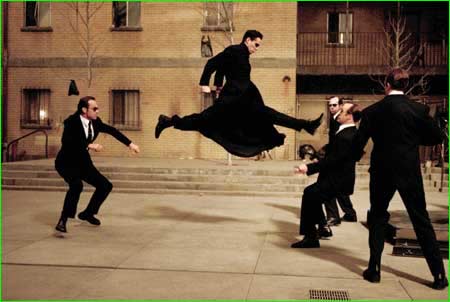(This edition is about babies, textbook Ph.D. defences and mind-viruses in Snow Crash, all of which can mostly be filed under backyard-philosophy(ish).)
On the theme of striving for The Next Level, my not-quite-1-month-old bundle of joy laughed out loud today for the first time! I’m sure that it was not a false alarm, as I was being my usual comedic genius self (I target the 1 to 3 month-old crowd), and the pattern of stimulus and reaction was just too well-coordinated and sustained to be coincidental.
On the theme of really cool events, on Thursday I had the privilege of being part of the Best Ph.D. Defence EVAR. Seriously people, the day that my good friend Frans Steenbrink became my good friend Dr. Frans Steenbrink will pleasantly resonate in my mind for a long time to come.

Here in NL, a Ph.D. defence is a fantastic affair: The candidate has to defend his work against the highly-experienced offensive mental manoeuvres of a committee consisting of around 7 wise men, most of them grizzled veteran professors who have eaten many a hapless candidate FOR BREAKFAST! As if that weren’t awe-inspiring enough, the defence usually takes place in some imposing building, preferably more than a few hundred years old (in this case, it was the Academiegebouw in Leiden, almost 500 hundred years old), the committee are in full academic (read: battle) garb, and the whole affair is public, so the candidate is joined by a potentially sizeable audience. Believe me, this can be a nauseatingly stressful experience.
Of course Dr. Steenbrink handled the whole affair with elegance and, extremely unusually, a healthy dose of humour. It might be the first time that I’ve ever seen a candidate disarm his opponents not only by artfully responding to their questions, but with an ever-so-slightly irreverent injection of humour. It was beautiful.
After the successful defence, we were all picked up by a boat and taken via the Leiden canals to De Poort for the after-party, and what an after-party it was… Besides the live performance of Frédérik Steenbrink, the two electro DJs, the superb saxophonist who was able to accompany them musically (!!!), the Louis Theroux-style documentary put together by Mr Cricket, and copious amounts of free beer, it was positively life-affirming to see the Master of Good Karma (the freshly minted doctor goes by many names) being surrounded by his Karma-children, all emanating. You need to know him in order to understand this completely, but you have to trust me that it was beautiful.
On the theme of understated super-heroes, I finally got around to reading Neal Stephenson’s Snow Crash, triggered by a Cosa Nostra t-shirt shown on boingboing. I know I know, I could have lost my Cyberpunk Nerd membership card for only reading it this late in my life…
In any case, I really enjoyed the book, especially for the characters (the protagonist, called Hiro Protagonist, is naturally a half-African American half-Korean hacker / sword-fighter / pizza delivery guy), the far-out society (the world is run by private franchises, amongst others the Mafia, owner of the extremely influential Cosa Nostra pizza chain and run by the charismatic Uncle Enzo), the crazy technological artefacts (the Rat Things!) and for all the changes in society brought about by the crazy technology, not least of which the Metaverse. The Metaverse is the name Stephenson gave to his extrapolation of various phenomena present or considered in 1992: The internet, virtual reality, Gibsonian cyberspace. The protagonists spend a portion of their time not quite jacked in, but with augmented reality goggles and high-fidelity ear-phones, walking around as avatars in an artificial world with a total population of slightly less than what facebook has now, if I remember correctly.
Personally, I didn’t find Snowcrash quite as good as Gibson’s Neuromancer (see my 2003 ode here. it still gives me goose-flesh…), but somehow, very sneakily, it has still managed to manoeuvre itself into my list of all-time favourite books.
The story is built around the interesting idea of a neuro-linguistic virus, that is a certain sequence of sounds that is somehow able to get into the human deep brain, screw things up royally and spread through verbal contact with other humans. It has a cyberspace equivalent called Snow Crash: If programmers in the Metaverse see this specially coded binary image (through their AR interfaces), their brains essentially crash and they’re turned into vegetables. It’s all very complex (see this wikipedia page) and quite far fetched, but the idea of considering certain large-scale social phenomena as a kind of mind-virus, that is a potentially damaging entity that integrates at very low level with its host, is self-replicating and is able to spread to other humans, is intriguing to say the least.
Recall that Dawkins partly coined the by now well-known English term “meme” in his 1976 book, The Selfish Gene, as it turns out that the concept was more or less first written about by Semon in 1904. A meme, analogous to a gene, is an element of social information, for example the mistaken idea that going outside in cold weather increases the chances of getting a cold (in this case, not true, but still a meme). Analogous to a biological virus, a mind-virus would then be built up from various memes. Each meme would take care of a different function of the mind-virus, helping to guarantee its survival and proliferation throughout humankind, for example: Don’t question me (meme1), believe in me (meme2), spread me (meme3), be exclusively faithful to me (meme4), do this or you will be severely punished (meme5), do this and you will be greatly rewarded (meme6).
If you’re wondering what I mean by all of this, rest assured in the fact that Zombo Com has all the answers.
Kids, now go and have yourselves a fantastic week!